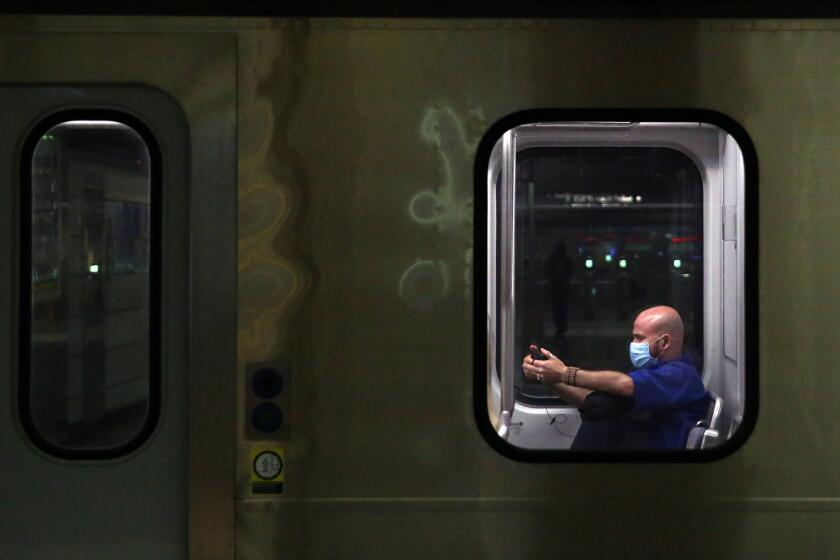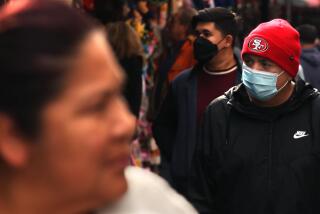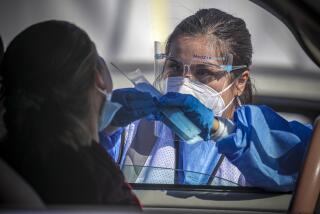California to obtain more masks, gear as it becomes state with most COVID-19 cases

- Share via
SACRAMENTO — On a day when California became the state with the most coronavirus infections in the U.S., Gov. Gavin Newsom said Wednesday that officials are redoubling efforts to secure protective gear and are preparing to expand the number of available hospital beds to handle a surge in patients.
With more than 409,000 cumulative COVID-19 cases in the state, California on Wednesday exceeded the number reported in New York by about 700 cases, according to data provided by Johns Hopkins University.
After leading the nation in the number of coronavirus cases, New York has since experienced a decline in infections, deaths and hospitalizations as numbers have climbed in California.
“We are a state the size of 21 states combined, so its not surprising now that as we have begun reopening key sectors of our economy and people continue to mix ... that our numbers would start to go up, in total the highest in the nation,” Newsom said, calling it “a sober reminder of why we are taking things as seriously as we are.”
On Wednesday, Newsom said that 12,807 people tested positive the day before, “the highest reported number in our state,” and that 115 Californians infected with the virus died in the last 24 hours.
“It’s just another proof point of how deadly this disease continues to be,” Newsom said.
At a news conference held in a Sacramento warehouse housing personal protective equipment, Newsom said he is extending a contract with Chinese firm BYD to buy 300 million more surgical masks and 120 million additional N95 face masks to protect medical workers and others, while he also seeks bids from companies that can provide protective gear in future months. The so-called bridge contract is worth $315 million.
The governor said the step is necessary because California is sending out 46 million masks per month and has an inventory of 111 million N95 masks.
“We were able to bend the curve many months ago in the state of California,” Newsom said. “That bought us time to purchase and procure the kind of equipment you see behind me and put together our plans.”
As one sign of the surge, Newsom announced Wednesday that Butte County has become the 35th county on a state watchlist of jurisdictions with high infection and hospitalization rates. Those counties on the list for three days must close many businesses where people gather, including restaurant dining rooms and movie theaters.
Newsom’s comments come on the heels of a new, urgent warning from the statewide organization representing hospital administrators that only about 5,000 hospital beds are available statewide, with shortages likely in some of the hardest-hit regions.
“They’re looking at nontraditional places in hospitals” to set up additional beds, said Carmela Coyle, president and chief executive of the California Hospital Assn.
Gov. Gavin Newsom said Wednesday that 12,807 new coronavirus infections had been reported statewide in the past 24 hours — a record high.
While the state has established additional locations to handle a surge of an additional 20,000 coronavirus patients, Coyle said Wednesday that current transmission rates also pose risks for staffing nurses with critical care training.
The hospitals association is asking the Newsom administration to seek additional federal help in providing staff and to rethink existing nurse-patient ratios as conditions worsen.
“We are looking at a far, faster race of increase than previously,” Coyle said.
Newsom said the state has a strategy “to address the prospect of a surge in hospital utilization, the need to develop alternative care sites outside of our hospital system to help isolate and quarantine individuals.”
The governor acknowledged that he continues to hear complaints from medical workers who are not getting enough medical masks and other protective equipment despite increased deliveries by the state.
He said one advocate for nurses told him recently that many are getting only two or three masks a week, although medical standards require more.
“That’s unacceptable,” Newsom said. “We still hear those stories and we have got to address that issue.”
With federal subsidies of unemployment benefits expiring this month, Newsom also said he hopes more federal help comes for residents who have lost work, noting there is “a growing recognition in Washington, D.C., that we are walking toward the edge of a cliff.” He said he may use executive powers to extend protections against evictions and to extend sick leave to Californians.
Newsom issued a stay-at-home order on March 19 that forced many businesses to close and initially kept a lid on the number of new infections caused by community spread.
When it appeared the curve of infections had flattened, the governor, faced with political pressure to reopen the economy, began rolling back the restrictions in early May, allowing Californians inside more stores and to eat inside restaurants.
But coronavirus cases began to spike, and on July 1 the governor ordered a return to restrictions on indoor activities for most of the state, including a ban on visits to indoor restaurants, bars, wineries, entertainment centers, movie theaters, zoos and card rooms.
The tougher rules apply to counties facing a surge in cases and hospitalizations, including Los Angeles, Riverside, Ventura, Orange and San Bernardino.
In addition, Newsom announced last week that schools will remain closed for in-classroom instruction in 32 counties where the spread of coronavirus remains a significant public health risk, forcing districts to prepare for online learning for their students.
Times staff writer John Myers contributed to the report.
More to Read
Sign up for Essential California
The most important California stories and recommendations in your inbox every morning.
You may occasionally receive promotional content from the Los Angeles Times.












